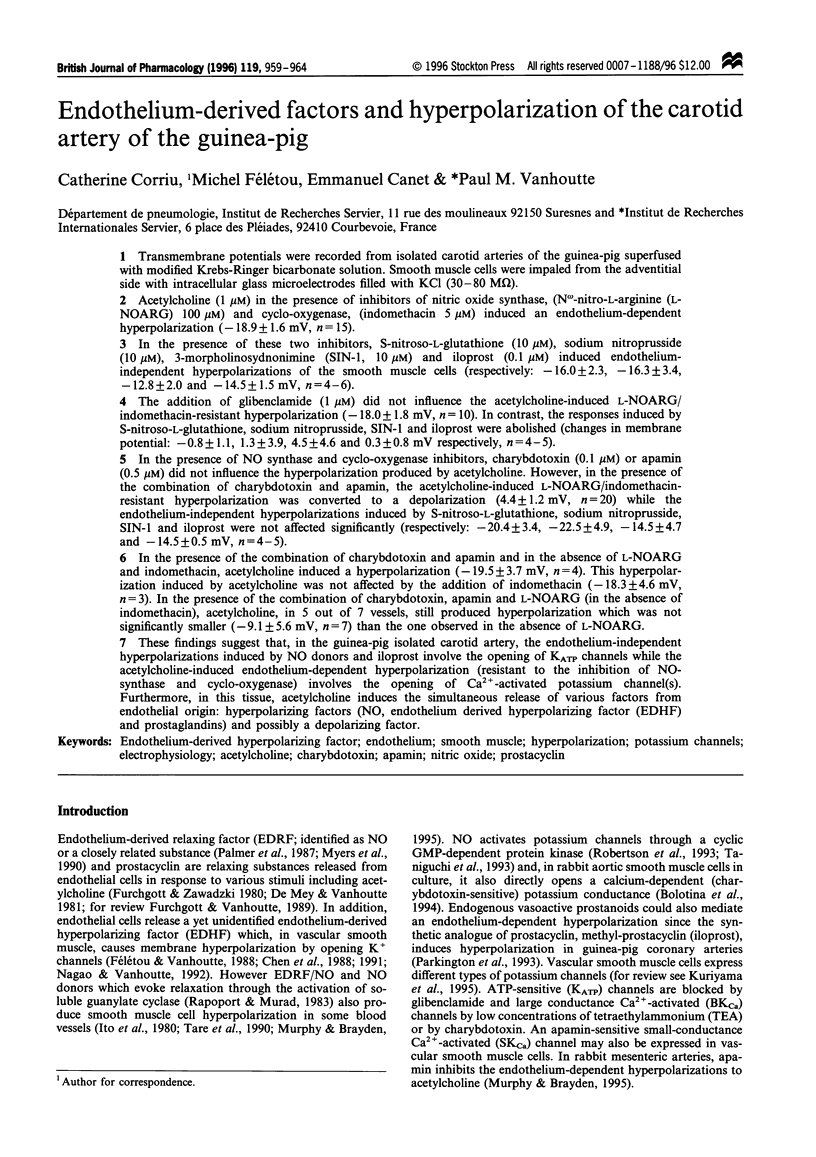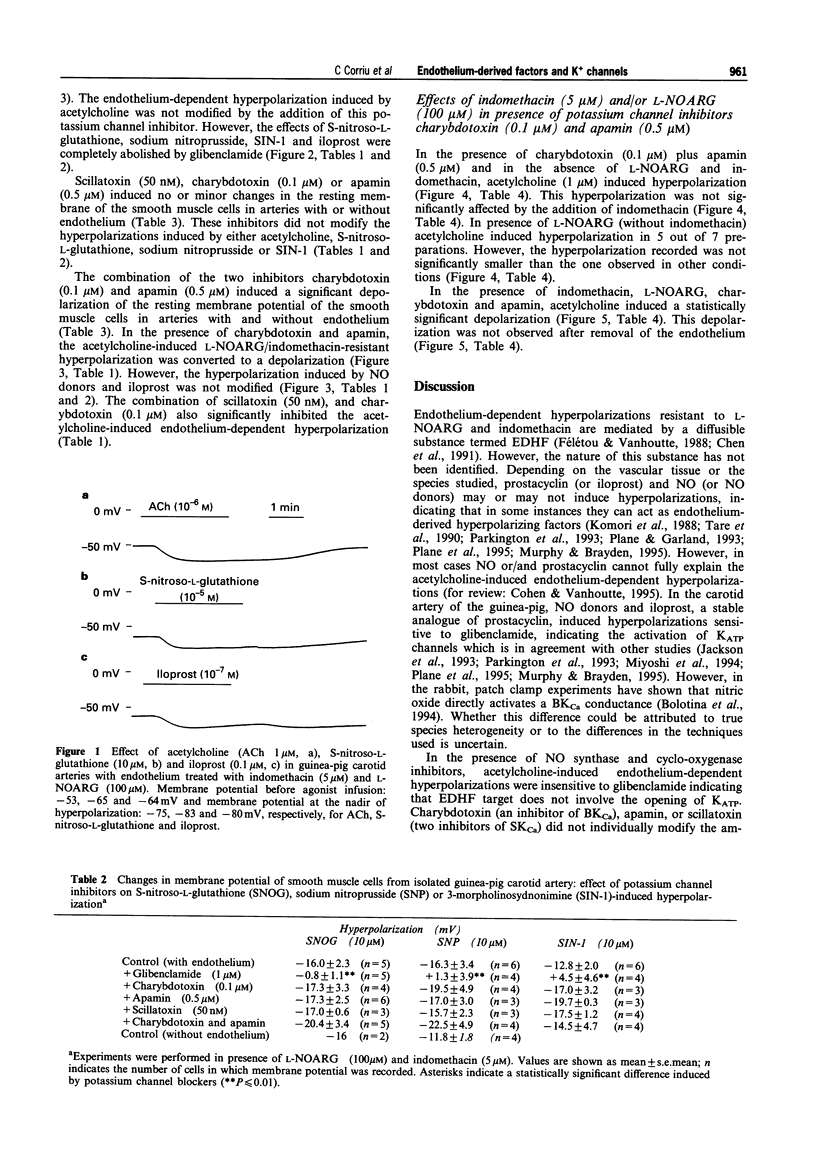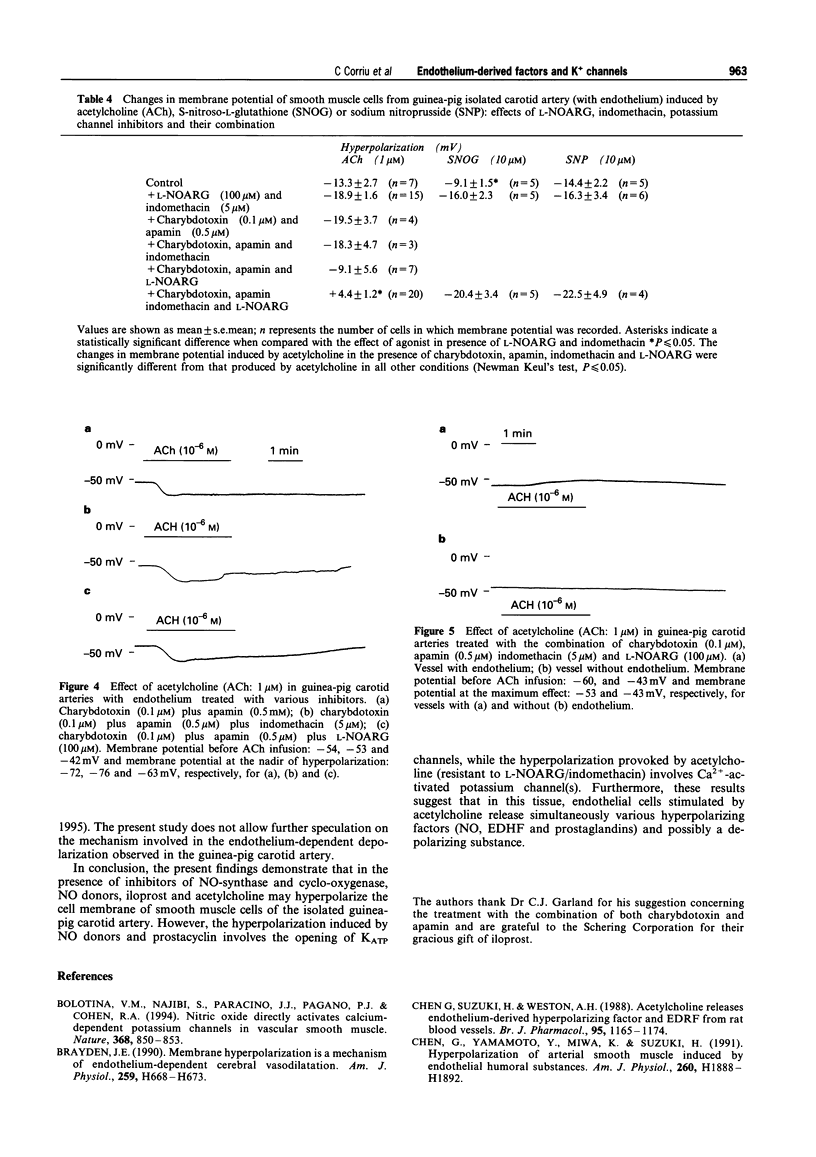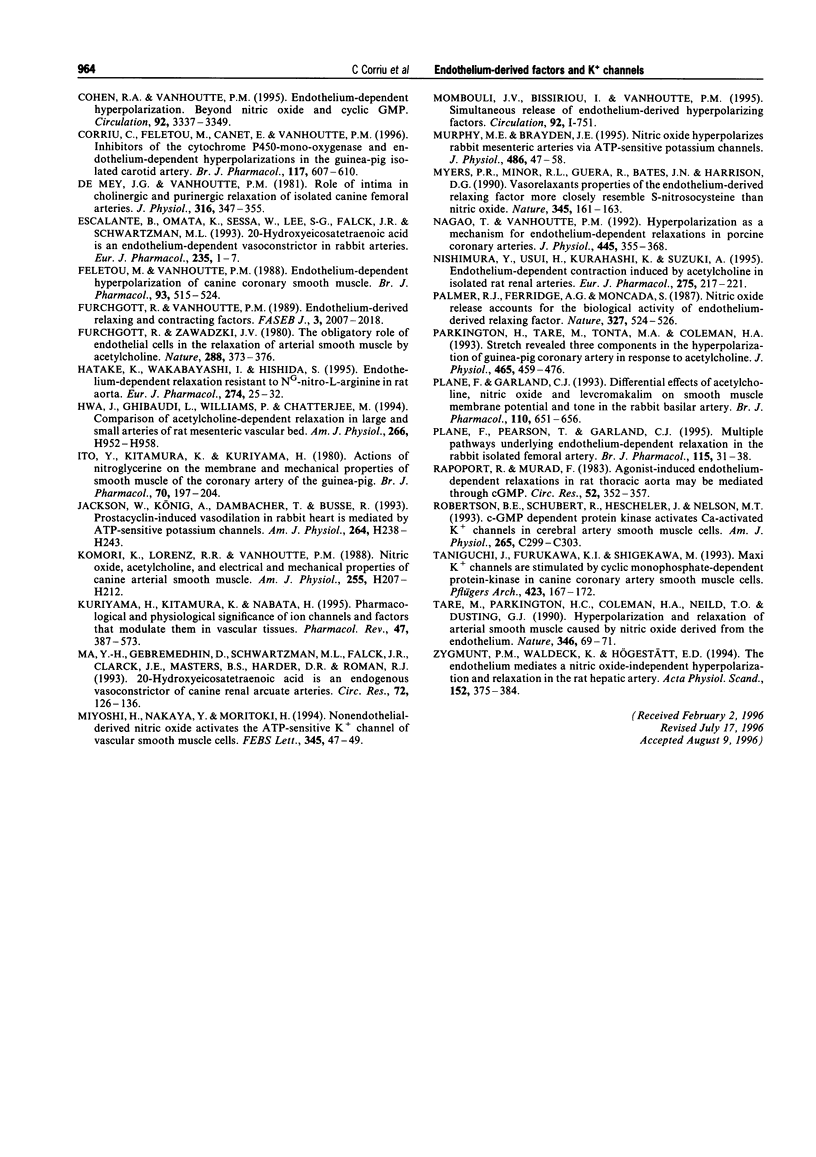Abstract
1. Transmembrane potentials were recorded from isolated carotid arteries of the guinea-pig superfused with modified Krebs-Ringer bicarbonate solution. Smooth muscle cells were impaled from the adventitial side with intracellular glass microelectrodes filled with KCl (30-80 M omega). 2. Acetylcholine (1 microM) in the presence of inhibitors of nitric oxide synthase, (N omega-nitro-L-arginine (L-NOARG) 100 microM) and cyclo-oxygenase, (indomethacin 5 microM) induced an endothelium-dependent hyperpolarization (-18.9 +/- 1.6 mV, n = 15). 3. In the presence of these two inhibitors, S-nitroso-L-glutathione (10 microM), sodium nitroprusside (10 microM), 3-morpholinosydnonimine (SIN-1, 10 microM) and iloprost (0.1 microM) induced endothelium-independent hyperpolarizations of the smooth muscle cells (respectively: -16.0 +/- 2.3, -16.3 +/- 3.4, -12.8 +/- 2.0 and -14.5 +/- 1.5 mV, n = 4-6). 4. The addition of glibenclamide (1 microM) did not influence the acetylcholine-induced L-NOARG/ indomethacin-resistant hyperpolarization (-18.0 +/- 1.8 mV, n = 10). In contrast, the responses induced by S-nitroso-L-glutathione, sodium nitroprusside, SIN-1 and iloprost were abolished (changes in membrane potential: -0.8 +/- 1.1, 1.3 +/- 3.9, 4.5 +/- 4.6 and 0.3 +/- 0.8 mV respectively, n = 4-5). 5. In the presence of NO synthase and cyclo-oxygenase inhibitors, charybdotoxin (0.1 microM) or apamin (0.5 microM) did not influence the hyperpolarization produced by acetylcholine. However, in the presence of the combination of charybdotoxin and apamin, the acetylcholine-induced L-NOARG/indomethacin-resistant hyperpolarization was converted to a depolarization (4.4 +/- 1.2 mV, n = 20) while the endothelium-independent hyperpolarizations induced by S-nitroso-L-glutathione, sodium nitroprusside, SIN-1 and iloprost were not affected significantly (respectively: -20.4 +/- 3.4, -22.5 +/- 4.9, -14.5 +/- 4.7 and -14.5 +/- 0.5 mV, n = 4-5). 6. In the presence of the combination of charybdotoxin and apamin and in the absence of L-NOARG and indomethacin, acetylcholine induced a hyperpolarization (-19.5 +/- 3.7 mV, n = 4). This hyperpolarization induced by acetylcholine was not affected by the addition of indomethacin (-18.3 +/- 4.6 mV, n = 3). In the presence of the combination of charybdotoxin, apamin and L-NOARG (in the absence of indomethacin), acetylcholine, in 5 out of 7 vessels, still produced hyperpolarization which was not significantly smaller (-9.1 +/- 5.6 mV, n = 7) than the one observed in the absence of L-NOARG. 7. These findings suggest that, in the guinea-pig isolated carotid artery, the endothelium-independent hyperpolarizations induced by NO donors and iloprost involve the opening of KATP channels while the acetylcholine-induced endothelium-dependent hyperpolarization (resistant to the inhibition of NO-synthase and cyclo-oxygenase) involves the opening of Ca(2+)-activated potassium channel(s). Furthermore, in this tissue, acetylcholine induces the simultaneous release of various factors from endothelial origin: hyperpolarizing factors (NO, endothelium derived hyperpolarizing factor (EDHF) and prostaglandins) and possibly a depolarizing factor.
Full text
PDF





Selected References
These references are in PubMed. This may not be the complete list of references from this article.
- Bolotina V. M., Najibi S., Palacino J. J., Pagano P. J., Cohen R. A. Nitric oxide directly activates calcium-dependent potassium channels in vascular smooth muscle. Nature. 1994 Apr 28;368(6474):850–853. doi: 10.1038/368850a0. [DOI] [PubMed] [Google Scholar]
- Brayden J. E. Membrane hyperpolarization is a mechanism of endothelium-dependent cerebral vasodilation. Am J Physiol. 1990 Sep;259(3 Pt 2):H668–H673. doi: 10.1152/ajpheart.1990.259.3.H668. [DOI] [PubMed] [Google Scholar]
- Chen G., Suzuki H., Weston A. H. Acetylcholine releases endothelium-derived hyperpolarizing factor and EDRF from rat blood vessels. Br J Pharmacol. 1988 Dec;95(4):1165–1174. doi: 10.1111/j.1476-5381.1988.tb11752.x. [DOI] [PMC free article] [PubMed] [Google Scholar]
- Chen G., Yamamoto Y., Miwa K., Suzuki H. Hyperpolarization of arterial smooth muscle induced by endothelial humoral substances. Am J Physiol. 1991 Jun;260(6 Pt 2):H1888–H1892. doi: 10.1152/ajpheart.1991.260.6.H1888. [DOI] [PubMed] [Google Scholar]
- Cohen R. A., Vanhoutte P. M. Endothelium-dependent hyperpolarization. Beyond nitric oxide and cyclic GMP. Circulation. 1995 Dec 1;92(11):3337–3349. doi: 10.1161/01.cir.92.11.3337. [DOI] [PubMed] [Google Scholar]
- Corriu C., Félétou M., Canet E., Vanhoutte P. M. Inhibitors of the cytochrome P450-mono-oxygenase and endothelium-dependent hyperpolarizations in the guinea-pig isolated carotid artery. Br J Pharmacol. 1996 Feb;117(4):607–610. doi: 10.1111/j.1476-5381.1996.tb15233.x. [DOI] [PMC free article] [PubMed] [Google Scholar]
- De Mey J. G., Vanhoutte P. M. Role of the intima in cholinergic and purinergic relaxation of isolated canine femoral arteries. J Physiol. 1981 Jul;316:347–355. doi: 10.1113/jphysiol.1981.sp013792. [DOI] [PMC free article] [PubMed] [Google Scholar]
- Escalante B., Omata K., Sessa W., Lee S. G., Falck J. R., Schwartzman M. L. 20-hydroxyeicosatetraenoic acid is an endothelium-dependent vasoconstrictor in rabbit arteries. Eur J Pharmacol. 1993 Apr 22;235(1):1–7. doi: 10.1016/0014-2999(93)90812-v. [DOI] [PubMed] [Google Scholar]
- Feletou M., Vanhoutte P. M. Endothelium-dependent hyperpolarization of canine coronary smooth muscle. Br J Pharmacol. 1988 Mar;93(3):515–524. doi: 10.1111/j.1476-5381.1988.tb10306.x. [DOI] [PMC free article] [PubMed] [Google Scholar]
- Furchgott R. F., Vanhoutte P. M. Endothelium-derived relaxing and contracting factors. FASEB J. 1989 Jul;3(9):2007–2018. [PubMed] [Google Scholar]
- Furchgott R. F., Zawadzki J. V. The obligatory role of endothelial cells in the relaxation of arterial smooth muscle by acetylcholine. Nature. 1980 Nov 27;288(5789):373–376. doi: 10.1038/288373a0. [DOI] [PubMed] [Google Scholar]
- Hatake K., Wakabayashi I., Hishida S. Endothelium-dependent relaxation resistant to NG-nitro-L-arginine in rat aorta. Eur J Pharmacol. 1995 Feb 14;274(1-3):25–32. doi: 10.1016/0014-2999(94)00704-b. [DOI] [PubMed] [Google Scholar]
- Hwa J. J., Ghibaudi L., Williams P., Chatterjee M. Comparison of acetylcholine-dependent relaxation in large and small arteries of rat mesenteric vascular bed. Am J Physiol. 1994 Mar;266(3 Pt 2):H952–H958. doi: 10.1152/ajpheart.1994.266.3.H952. [DOI] [PubMed] [Google Scholar]
- Ito Y., Kitamura K., Kuriyama H. Actions of nitroglycerine on the membrane and mechanical properties of smooth muscles of the coronary artery of the pig. Br J Pharmacol. 1980 Oct;70(2):197–204. doi: 10.1111/j.1476-5381.1980.tb07925.x. [DOI] [PMC free article] [PubMed] [Google Scholar]
- Jackson W. F., König A., Dambacher T., Busse R. Prostacyclin-induced vasodilation in rabbit heart is mediated by ATP-sensitive potassium channels. Am J Physiol. 1993 Jan;264(1 Pt 2):H238–H243. doi: 10.1152/ajpheart.1993.264.1.H238. [DOI] [PubMed] [Google Scholar]
- Komori K., Lorenz R. R., Vanhoutte P. M. Nitric oxide, ACh, and electrical and mechanical properties of canine arterial smooth muscle. Am J Physiol. 1988 Jul;255(1 Pt 2):H207–H212. doi: 10.1152/ajpheart.1988.255.1.H207. [DOI] [PubMed] [Google Scholar]
- Kuriyama H., Kitamura K., Nabata H. Pharmacological and physiological significance of ion channels and factors that modulate them in vascular tissues. Pharmacol Rev. 1995 Sep;47(3):387–573. [PubMed] [Google Scholar]
- Ma Y. H., Gebremedhin D., Schwartzman M. L., Falck J. R., Clark J. E., Masters B. S., Harder D. R., Roman R. J. 20-Hydroxyeicosatetraenoic acid is an endogenous vasoconstrictor of canine renal arcuate arteries. Circ Res. 1993 Jan;72(1):126–136. doi: 10.1161/01.res.72.1.126. [DOI] [PubMed] [Google Scholar]
- Miyoshi H., Nakaya Y., Moritoki H. Nonendothelial-derived nitric oxide activates the ATP-sensitive K+ channel of vascular smooth muscle cells. FEBS Lett. 1994 May 23;345(1):47–49. doi: 10.1016/0014-5793(94)00417-x. [DOI] [PubMed] [Google Scholar]
- Murphy M. E., Brayden J. E. Nitric oxide hyperpolarizes rabbit mesenteric arteries via ATP-sensitive potassium channels. J Physiol. 1995 Jul 1;486(Pt 1):47–58. doi: 10.1113/jphysiol.1995.sp020789. [DOI] [PMC free article] [PubMed] [Google Scholar]
- Myers P. R., Minor R. L., Jr, Guerra R., Jr, Bates J. N., Harrison D. G. Vasorelaxant properties of the endothelium-derived relaxing factor more closely resemble S-nitrosocysteine than nitric oxide. Nature. 1990 May 10;345(6271):161–163. doi: 10.1038/345161a0. [DOI] [PubMed] [Google Scholar]
- Nagao T., Vanhoutte P. M. Hyperpolarization as a mechanism for endothelium-dependent relaxations in the porcine coronary artery. J Physiol. 1992 Jan;445:355–367. doi: 10.1113/jphysiol.1992.sp018928. [DOI] [PMC free article] [PubMed] [Google Scholar]
- Nishimura Y., Usui H., Kurahashi K., Suzuki A. Endothelium-dependent contraction induced by acetylcholine in isolated rat renal arteries. Eur J Pharmacol. 1995 Mar 6;275(2):217–221. doi: 10.1016/0014-2999(95)00023-e. [DOI] [PubMed] [Google Scholar]
- Palmer R. M., Ferrige A. G., Moncada S. Nitric oxide release accounts for the biological activity of endothelium-derived relaxing factor. Nature. 1987 Jun 11;327(6122):524–526. doi: 10.1038/327524a0. [DOI] [PubMed] [Google Scholar]
- Parkington H. C., Tare M., Tonta M. A., Coleman H. A. Stretch revealed three components in the hyperpolarization of guinea-pig coronary artery in response to acetylcholine. J Physiol. 1993 Jun;465:459–476. doi: 10.1113/jphysiol.1993.sp019687. [DOI] [PMC free article] [PubMed] [Google Scholar]
- Plane F., Garland C. J. Differential effects of acetylcholine, nitric oxide and levcromakalim on smooth muscle membrane potential and tone in the rabbit basilar artery. Br J Pharmacol. 1993 Oct;110(2):651–656. doi: 10.1111/j.1476-5381.1993.tb13861.x. [DOI] [PMC free article] [PubMed] [Google Scholar]
- Plane F., Pearson T., Garland C. J. Multiple pathways underlying endothelium-dependent relaxation in the rabbit isolated femoral artery. Br J Pharmacol. 1995 May;115(1):31–38. doi: 10.1111/j.1476-5381.1995.tb16316.x. [DOI] [PMC free article] [PubMed] [Google Scholar]
- Rapoport R. M., Murad F. Agonist-induced endothelium-dependent relaxation in rat thoracic aorta may be mediated through cGMP. Circ Res. 1983 Mar;52(3):352–357. doi: 10.1161/01.res.52.3.352. [DOI] [PubMed] [Google Scholar]
- Robertson B. E., Schubert R., Hescheler J., Nelson M. T. cGMP-dependent protein kinase activates Ca-activated K channels in cerebral artery smooth muscle cells. Am J Physiol. 1993 Jul;265(1 Pt 1):C299–C303. doi: 10.1152/ajpcell.1993.265.1.C299. [DOI] [PubMed] [Google Scholar]
- Smith S. C., Jr AHA president's letter. Circulation. 1995 Jul 1;92(1):1–1. [PubMed] [Google Scholar]
- Taniguchi J., Furukawa K. I., Shigekawa M. Maxi K+ channels are stimulated by cyclic guanosine monophosphate-dependent protein kinase in canine coronary artery smooth muscle cells. Pflugers Arch. 1993 May;423(3-4):167–172. doi: 10.1007/BF00374390. [DOI] [PubMed] [Google Scholar]
- Tare M., Parkington H. C., Coleman H. A., Neild T. O., Dusting G. J. Hyperpolarization and relaxation of arterial smooth muscle caused by nitric oxide derived from the endothelium. Nature. 1990 Jul 5;346(6279):69–71. doi: 10.1038/346069a0. [DOI] [PubMed] [Google Scholar]
- Zygmunt P. M., Waldeck K., Högestätt E. D. The endothelium mediates a nitric oxide-independent hyperpolarization and relaxation in the rat hepatic artery. Acta Physiol Scand. 1994 Dec;152(4):375–384. doi: 10.1111/j.1748-1716.1994.tb09819.x. [DOI] [PubMed] [Google Scholar]


